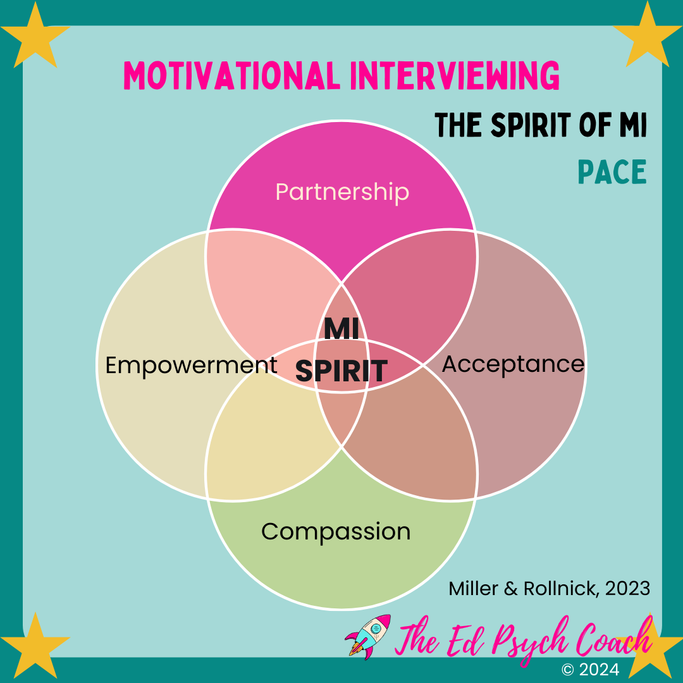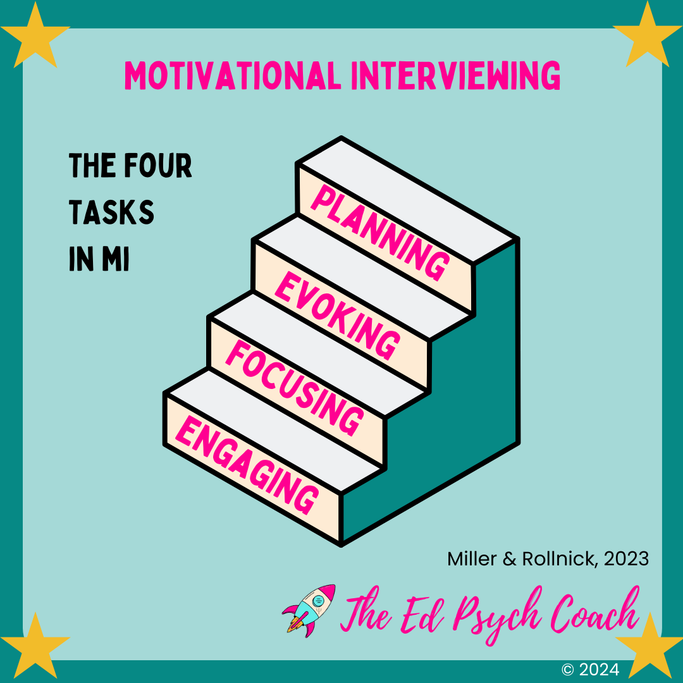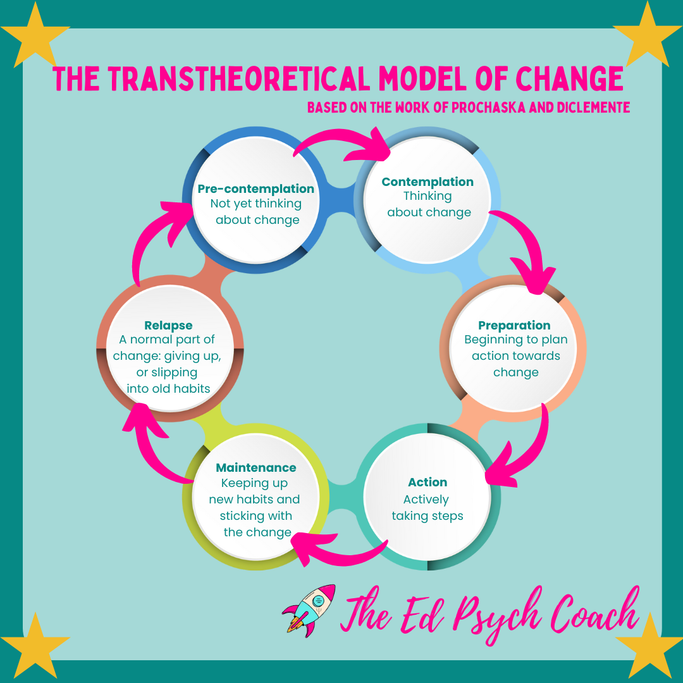
Are you considering change or growth in your EP career?
10 ways that Motivational Interviewing might help
(8-minute read)
Are you considering some kind of change or growth in your EP career? How about any of these:
- finding more meaning, fulfilment and purpose in your work?
- considering your contribution and the difference you want to make?
- discovering and developing your niche?
- publishing or presenting your thesis/other research?
- considering a specialist/leadership position? Or deciding if that’s the path for you?
- broadening your range of EP work to include more systemic and creative work?
Change is a natural part of the rhythm of life. Sometimes change feels like it happens upon us. And sometimes we can be active agents in creating positive change for ourselves. I am talking about the kind of change that feels like growth, development, progression, accomplishment and achievement. This is my jam: I love supporting EPs in their career growth, so we can maximise the difference we make.
When thinking about change, we sometimes get stuck along the way. We may have mixed feelings about change: we sort of do want the change, and we sort of don’t. We might experience a sense of inertia. This is known as ambivalence. It’s a very natural part of the change process.
***
The psychology of Motivational Interviewing (MI; Miller and Rollnick, 2023) - originally developed to help people reduce alcohol, smoking and substance use – offers ways to support people experiencing ambivalence. It can be used when considering career change and growth.
Here’s 10 ways that Motivational Interviewing might be useful to you:
1. MI lets you choose what’s right for you.
An MI coach facilitates the thinking space for you to choose what, if any, changes you might like to make. Autonomy is one of the key principles of MI (Miller and Rollnick, 2013). An MI coach might say things like:
- “This is your choice to make.”
- “It’s up to you to decide what, if anything, you do next.”
- “You can choose which direction you want to go in.”
2. MI is kind, compassionate and non-judgmental.
The spirit of MI has four key components: partnership, acceptance, compassion and empowerment ('PACE', Miller and Rollnick, 2023; Figure 1). Compassion is all about kindness, empathy, understanding and seeking to help improve matters for a person. Acceptance is about allowing you to be ‘unapologetically you.’ If you’re self-coaching, you can try to exercise self-compassion and self-acceptance.
Figure 1: The spirit of MI
3. MI is a collaborative partnership.
MI uses a guiding style to help you consider change. Your MI coach is there to guide you, not direct you. Collaboration and partnership are key (Figure 1). A skillful MI coach will be able to resist ‘the fixing reflex’: the tendency to slip into a directive style when seeking to help, such as ‘telling’, ‘persuading’ or ‘advising’ others (Miller and Rollnick, 2023). An effective MI coach will partner with you to elicit your own thoughts about the change and help you work out what’s best for you.
4. MI helps you get unstuck.
“The most common place to get stuck on the road to change is ambivalence.”
(Miller and Rollnick, 2013, p. 6).
An MI coach can ‘sit on the fence’ alongside you and seek to understand your ambivalence. MI uses Evocation (Figure 2) and this is the main distinguishing feature of MI. By eliciting and strengthening your own reasons, desire and need for change, an MI coach can help you to overcome ambivalence and get unstuck. You can coach yourself on this too: see my free self-coaching workbook (coming soon).
5. MI helps you get focused.
MI has four tasks (Miller & Rollnick, 2023; Figure 2), which are used flexibly and not linear. Once your MI coach has built engagement and rapport, they will guide you to getting focused. An MI coach might say things like this (or you could ask yourself – see my self-coaching tool):
- “What sort of change are you considering?”
- “I wonder if you already have a goal in mind, and what your goal might be…”
- “I wonder what you might like to focus on?”
Figure 2: The four tasks in MI
6. MI helps you find forward momentum.
There is hot debate in the MI community about its link with the transtheoretical model of change (TTM, Prochaska and DiClemente, 1984, cited by Miller and Rollnick, 2009; Figure 3). In their paper called ‘10 things MI is not,’ Miller and Rollnick (2009, p. 130) describe MI and the TTM as separate and different, but others have argued the usefulness of the TTM in MI to understand behaviour change. Regardless, MI helps you gain forward momentum towards positive change. Figure 2 (above) outlines the tasks in MI, which build towards planning and taking action.
Figure 3: The transtheoretical model of change
7. MI strengthens your commitment to change.
An MI coach might ask (or you could ask yourself), “on a scale of 0-10, where 0 is totally insignificant, and 10 is your top priority in life, how important is this change for you, at this moment?”
This is likely to elicit what’s important about this change or goal for you. An MI coach will attend to statements that you make in favour of change (known as ‘change talk’, Miller and Rollnick, 2013) and skillfully reflect them back to you. You can write them down if you’re self-coaching. This serves to build your motivation and strengthen your commitment to change.
8. MI builds your confidence.
MI can help build your confidence by giving affirmations of your strengths, resources and past successes. An MI coach might explore your perceived ability to make a change, so that your confidence can be boosted when needed. For example, an MI coach might use scaling to ask, “on a scale of 0-10, where 0 is rock bottom, and 10 is beaming confidence, how would you describe your confidence to make this change?”
An MI coach can also use affirmations to build confidence, such as:
- “I’m in awe of your resilience and the way you have bounced back.”
- “Wow. Even though this is challenging for you, you are determined to make it happen.”
- “I admire your courage in taking that step.”
You can use self-affirmations too: some of my coachees like to make affirmations posters with the sentence starters “I am..” and “I can…”
9. MI goes at your pace.
MI is often described as a ‘dance’ towards change. A tentative salsa step forward. And back. A sudden tango charge forward together. And stop. Then an enormous ballet jeté across the stage together. An MI coach will invite you to become ‘dance partners’, tune into which style of ‘dance’ suits your journey toward change, and dance with you in the idea of change, at your pace.
If you’re self-coaching, it can help to have an accountability partner to help you keep pace and momentum. This is also built into my self-coaching workbook (coming soon).
10. If/when you are ready to make the change, MI helps you make a plan and stick with it.
You may decide that you prefer not to make the change and that’s totally up to you (autonomy 😉). If you do find momentum towards change and you feel ready to take action, MI coaching can support you to consider what steps you might take. This is known as the ‘planning’ task (Figure 2). MI coaching can also support with accountability and helping you to stick with your plan.
Summary
If you are considering career change or career growth, MI can help you to choose what’s right for you, get focused, get unstuck, build confidence, find forward momentum and take action towards positive change. These ideas can be applied within coaching, supervision and/or self-coaching.
Next Steps
It’s totally up to you what you do next, of course. Here are some next steps to consider:
- You could read my blog 'What is Coaching?
- You could read more about coaching with me.
- You could get in touch to let me know your thoughts on this blog.
***
p.s. Want to be first to read more like this and access my special offers? Join my mailing list.
References
Miller, W. R., & Rollnick, S. (2013). Motivational interviewing: Helping people change (3rd ed.). New York: The Guildford Press.
Miller, W. R., & Rollnick, S. (2023). Motivational interviewing: Helping people change and grow (4th ed.). New York: The Guildford Press.
Miller, W. R., & Rollnick, S. (2009). Ten Things that Motivational Interviewing Is Not. Behavioural and Cognitive Psychotherapy, 37, 129–140.
© The Ed Psych Coach, 2024. All rights reserved.



